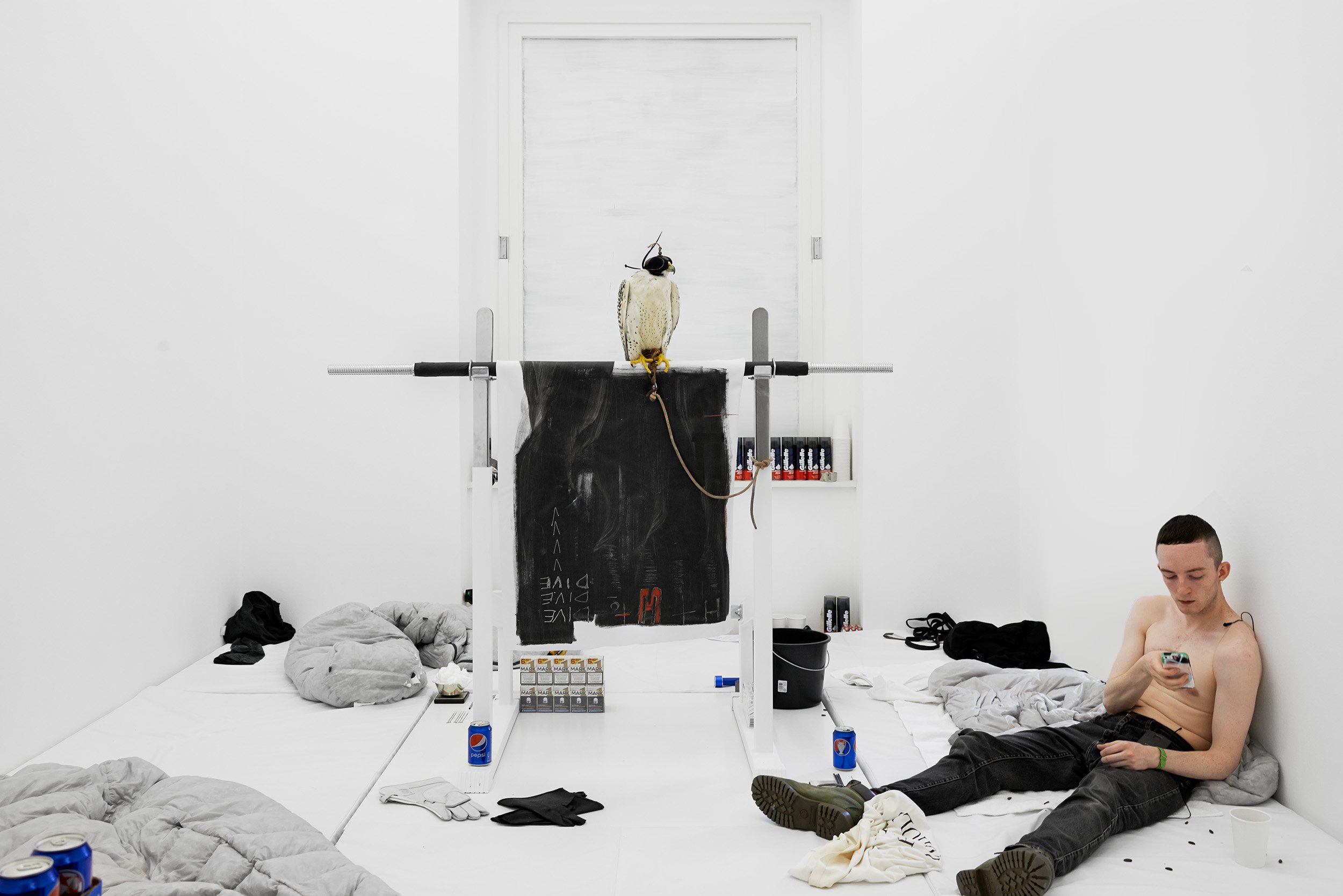
If you are not yet familiar with the work of German artist Anne Imhof, it’s time to change that. But be warned, getting acquainted with her practice isn’t easy.
Imhof, who won Berlin’s Preis der Nationalgalerie for young artists last year, is the name on everybody’s lips at this edition of Art Basel, where she is featured with a triumphant solo show titled “Angst” at the Kunsthalle Basel.
The artist—who is now represented by two of Germany’s hottest galleries, Isabella Bortolozzi and Galerie Buchholz—refers to the structure of the show as an “opera.” But rather than a narrative-driven sung musical score, Imhof is alluding to its Latin meaning, of “work” or “care.” There are multiple pieces installed in the museum’s second-level galleries that make up the set for—or are the remnants of—the actions dutifully carried out by a series of performers.
Each of the characters appear at the museum at different times throughout the show’s duration. However, on Wednesday night, all actors in Imhof’s electrifying show activated the stage together—including a character called The Prophet, “played” by a live falcon—for a five-hour-long performance titled “Act I.”
Anne Imhof Angst Kunsthalle Basel (2016). Photo: Philipp Hänger, courtesy Kunsthalle Basel.
At around 10pm, an audience that included heavy-hitting curators and collectors, such as Valeria Napoleone, whose Valeria Napoleone XX Foundation is one of the sponsors of this ambitious show, spilled into the Kunsthalle from all the different dinner parties that were slowly winding down, to enter into the solemn and enigmatic scenery of Imhof’s making.
A round, double-decker pool installed in the middle of the large hall is filled with water and Pepsi. There are numerous branded items in the scenography, including bottles of Gillette shaving foam, shrink-wrapped packages of the aforementioned soft drink, and various sports brands worn by the performers.
There are paintings depicting the different characters hung on the walls, and elongated white leather and resin sculptures are suspended from the ceiling, resembling stretched-out punching bags.
Anne Imhof Angst Kunsthalle Basel (2016). Photo: Dominik Asche, courtesy Kunsthalle Basel.
There’s certainly a nod to Matthew Barney’s vision in the epic interactions and images invoked by Imhof’s opera; performers hum an enchanting tune, drink, smoke, and glide along the stainless steel bars that lead from the main gallery to an adjacent room.
Performers would also occasionally take out a smartphone and then either lie immobile or become the alternating carriers of the action. (I later found out that Imhof was texting them with directions throughout the evening.) At one point, all performers gathered in the third and last room on the second level, which is also the smallest. As a group, they started singing, while staring back intensely at their audience, and the falcon, which seemed inanimate until that point, suddenly turned its head.
Anne Imhof Angst Kunsthalle Basel (2016). Photo: Dominik Asche, courtesy Kunsthalle Basel.
As if on cue, one dancer peels off her shirt, while another applies shaving foam to her torso; a different actor lathers the back of someone’s knees with the scented white substance, and slowly removes the foam with a razor.
There is no explanation, no linearity, or development to the situations that unfold around the space—only momentary images, as cryptic as they are overpowering. The audience was largely transfixed, which was a considerable achievement on a night when several high-profile parties were taking place.
Anne Imhof Angst Kunsthalle Basel (2016). Photo: Philipp Hänger, courtesy Kunsthalle Basel.
Imhof is a meticulous director, and there isn’t an element in the show that isn’t coded: there are hints to nightlife, nods to performance art’s grandest moments, topical markers like Accelerationism, and a cast of performers that embody a certain neo-bohemian type, their scrawny bodies bearing tattoos. However, this is not employing Ragnar Kjartansson’s grand durational approach, but instead is offering subtler gestures.
Imhof might be doing her job too perfectly, though. From the paintings on the walls to the overall aesthetics of the happening, the exhibition seems very much of its time, with several tropes checked off some current art world bucket list. Nonetheless, while acutely aware of her command of trends, I surrendered to the artist’s spell and let myself be lured by her modern, stylish myths.
For those who missed it in Basel, the show will also be performed at La Biennale de Montreal, which co-commissioned the piece, in October.